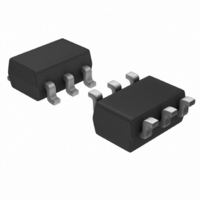LT1616ES6#TRM Linear Technology, LT1616ES6#TRM Datasheet - Page 10

LT1616ES6#TRM
Manufacturer Part Number
LT1616ES6#TRM
Description
IC SW REG STEP-DN 1.4MHZ SOT23-6
Manufacturer
Linear Technology
Type
Step-Down (Buck)r
Datasheet
1.LT1616ES6TRMPBF.pdf
(16 pages)
Specifications of LT1616ES6#TRM
Internal Switch(s)
Yes
Synchronous Rectifier
No
Number Of Outputs
1
Voltage - Output
3.3V, 5V
Current - Output
600mA
Frequency - Switching
1.4MHz
Voltage - Input
3.6 ~ 25 V
Operating Temperature
-40°C ~ 85°C
Mounting Type
Surface Mount
Package / Case
SOT-23-6
Lead Free Status / RoHS Status
Contains lead / RoHS non-compliant
Power - Output
-
Other names
LT1616ES6#TRMTR
Available stocks
Company
Part Number
Manufacturer
Quantity
Price
APPLICATIO S I FOR ATIO
LT1616
BOOST Pin Considerations
Capacitor C3 and diode D2 are used to generate a boost
voltage that is higher than the input voltage. In most cases
a 0.01 F capacitor and fast switching diode (such as the
1N4148 or 1N914) will work well. Figure 5 shows two
ways to arrange the boost circuit. The BOOST pin must be
more than 2.5V above the SW pin for best efficiency. For
outputs of 3.3V and above, the standard circuit (Figure 5a)
is best. For outputs between 2.8V and 3.3V, use a 0.033 F
capacitor and a small Schottky diode (such as the
BAT-54). For lower output voltages the boost diode can be
tied to the input (Figure 5b). The circuit in Figure 5a is more
efficient because the BOOST pin current comes from a
lower voltage source. You must also be sure that the
maximum voltage rating of the BOOST pin is not exceeded.
The minimum operating voltage of an LT1616 application
is limited by the undervoltage lockout (< 3.6V) and by the
maximum duty cycle as outlined above. For proper start-
up, the minimum input voltage is also limited by the boost
circuit. If the input voltage is ramped slowly, or the LT1616
is turned on with its SHDN pin when the output is already
in regulation, then the boost capacitor may not be fully
10
Figure 5. Two Circuits for Generating the Boost Voltage
V
V
IN
IN
V
MAX V
V
MAX V
BOOST
BOOST
V
BOOST
V
BOOST
D2
IN
– V
IN
– V
U
SW
SW
LT1616
LT1616
BOOST
BOOST
GND
GND
V
2V
V
IN
V
IN
OUT
IN
+ V
U
SW
SW
OUT
(5a)
(5b)
W
C3
C3
D2
1616 F05b
1616 F05a
V
OUT
U
V
OUT
charged. Because the boost capacitor is charged with the
energy stored in the inductor, the circuit will rely on some
minimum load current to get the boost circuit running
properly. This minimum load will depend on input and
output voltages, and on the arrangement of the boost
circuit. The minimum load generally goes to zero once the
circuit has started. Figure 6 shows a plot of minimum load
to start and to run as a function of input voltage. In many
cases the discharged output capacitor will present a load
to the switcher which will allow it to start. The plots show
the worst-case situation where V
Use a Schottky diode (such as the BAT-54) for the lowest
start-up voltage.
Figure 6. The Minimum Input Voltage Depends
on Output Voltage, Load Current and Boost Circuit
7
6
5
4
3
9
8
7
6
5
4
Minimum Input Voltage V
1
1
V TO START
Minimum Input Voltage V
TIED TO OUTPUT
TIED TO OUTPUT
V TO START
V TO RUN
V TO RUN
BOOST DIODE
BOOST DIODE
LOAD CURRENT (mA)
LOAD CURRENT (mA)
TIED TO INPUT
10
10
BOOST DIODE
TIED TO INPUT
BOOST DIODE
IN
V
D
V
D
OUT
OUT
BOOST
BOOST
is ramping very slowly.
100
100
OUT
= 3.3V
= 5V
OUT
= BAT54
= BAT54
= 3.3V
1616 F06a
1616 F06b
= 5V
500
500













